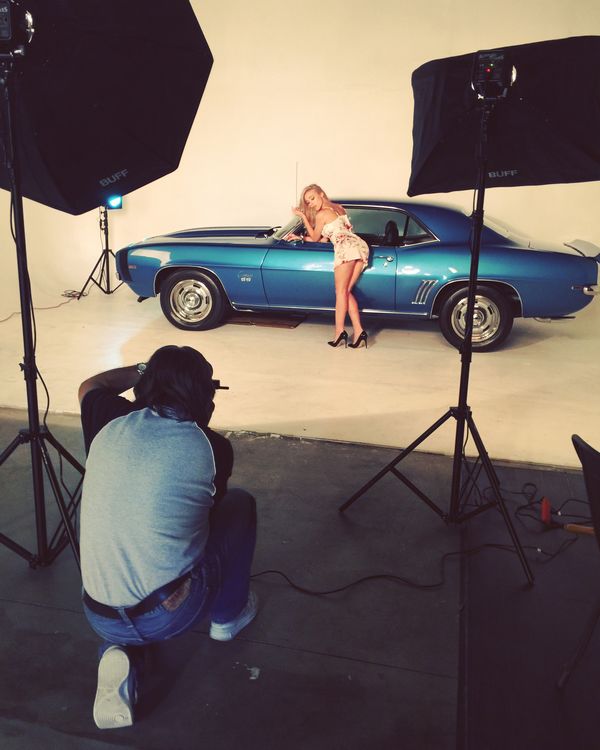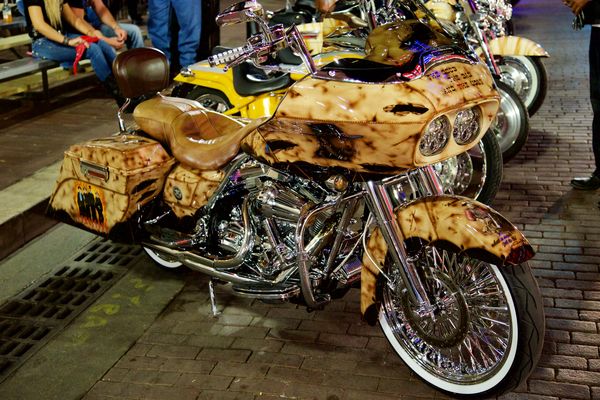Circular Polarizing Filter
Dec 28, 2017 12:32:58 #
Does anyone, or has anyone used a polarized filter in a studio with lighting? And what were the affects or outcomes? I'm asking this question because someone suggested I try one on my lens to reduce reflection from my soft-boxes. Open to any and all suggestions.

Dec 28, 2017 12:35:59 #
I've not, to date. I've eliminated glare by careful placement of lights. Additionally, with some subjects, a bit of highlight glare is necessary to augment the form or shape. However, your question does inspire me to take mine and use it just to see if it makes a difference.
--Bob
--Bob
RanCapp wrote:
Does anyone, or has anyone used a polarized filter in a studio with lighting? And what were the affects or outcomes? I'm asking this question because someone suggested I try one on my lens to reduce reflection from my soft-boxes. Open to any and all suggestions.
Dec 28, 2017 12:41:44 #
RanCapp wrote:
Does anyone, or has anyone used a polarized filter in a studio with lighting? And what were the affects or outcomes? I'm asking this question because someone suggested I try one on my lens to reduce reflection from my soft-boxes. Open to any and all suggestions.
It will reduce or eliminate glare from the windows. It will NOT affect the glare on the chrome at all. As for the paint, I have had mixed results, never good with metallic or pearl base paints, but some success on standard paints, depending upon the number of clear coats applied.
Dec 28, 2017 14:18:07 #
Dec 28, 2017 14:29:50 #
RanCapp wrote:
MT Shooter - Is 7 coats of clear too many?
I once shot a motorcycle with 18 coats, but it was over purple and gold pearl, reflections and glare were terribly unforgiving. All I can suggest is just give a CPL a try on your next shoot. See the difference with and without for yourself.
Dec 28, 2017 14:38:50 #
Since you're shooting in studio, would the DeHaze filter in Lightroom make a difference in post production?
Dec 28, 2017 16:38:37 #
RanCapp wrote:
Does anyone, or has anyone used a polarized filter in a studio with lighting? And what were the affects or outcomes? I'm asking this question because someone suggested I try one on my lens to reduce reflection from my soft-boxes. Open to any and all suggestions.
This was taken at night under city street lighting. The paint on the bike is beautifully done but it is a bitch to photograph. The leather of the saddle shines as much as the chrome and paint. No cpl was used for the shot, it probably would not have helped. The shadows tell the lighting problem, too much and from too many directions. This bike was built to attract attention and that it does. The detail of the paint is quite good, Clint Eastwood's image (side of gas tank) is life-like. W/W tires even look good.
Dec 28, 2017 16:42:20 #
davidrb wrote:
This was taken at night under city street lighting... (show quote)
Nice job. But DAMN! The money spent on paint was almost wasted because the backrest is stock black rather than reupholstered to match the seat.

Dec 28, 2017 20:29:43 #
RanCapp wrote:
Does anyone, or has anyone used a polarized filter in a studio with lighting? And what were the affects or outcomes? I'm asking this question because someone suggested I try one on my lens to reduce reflection from my soft-boxes. Open to any and all suggestions.
A polarizer will get rid of some of the reflections but not the majority of them... I'd suggest lighting such a scene with large white translucent parachutes (lit from behind)... placing one on each side of the studio... large soft light sources that would diminish the shadows and make for soft reflections across the auto where light reflections could be seen. The entire scene would be lit more like a bright hazy day outside... Naturally you would need to light the background in some areas.
Auto shoots I've seen done very well also added a very large scrim (parachute) from above on a 270 degree cyclorama background .... the autos never looked better.
I'm sure you could do some quality Photoshop work to minimize the reflections on the car and to lessen the shadows of the model against the car and floor.
Nice concept ... I'm betting with a bit of Photoshop the show will look very fine.
Rod
Dec 29, 2017 10:15:54 #
I would answer the question if I could take my eyes off the woman in the composition. Don't do this to me!
Dec 29, 2017 10:24:49 #
amfoto1
Loc: San Jose, Calif. USA
Car? What car? 
It certainly wouldn't hurt to try a CPL. I've used them with reflective surfaces of various types in studio shoots w/strobes... though it was small products and some portraits mostly. Nothing as large as a car.
It's also possible to polarize the output from the strobes themselves. Polarizing "gels" are available.. But to be totally honest, I've never done that, so don't know how well it works.
Sometimes you don't want to completely eliminate reflections... it can look strange with none or the reflections might define the shape of something transparent that's important to show. Photographing clear glass objects is a good example, where reflections actually are essential to define the shape of the object. The adjustability of a CPL filter allows me to control and reduce reflections, without completely eliminating them. Dunno if that's possible when polarizing the lights themselves.

It certainly wouldn't hurt to try a CPL. I've used them with reflective surfaces of various types in studio shoots w/strobes... though it was small products and some portraits mostly. Nothing as large as a car.
It's also possible to polarize the output from the strobes themselves. Polarizing "gels" are available.. But to be totally honest, I've never done that, so don't know how well it works.
Sometimes you don't want to completely eliminate reflections... it can look strange with none or the reflections might define the shape of something transparent that's important to show. Photographing clear glass objects is a good example, where reflections actually are essential to define the shape of the object. The adjustability of a CPL filter allows me to control and reduce reflections, without completely eliminating them. Dunno if that's possible when polarizing the lights themselves.
Dec 29, 2017 13:31:17 #
I agree. Better to adjust the lighting. You can use sheet polarizer film to polarize the lights as well, BTW.
Polarizers work because regular light (which is not polarized) gets polarized when it reflects off of any non-metallic surface. The polarized reflection can then be cancelled with the filter. Metallic paint usually has flakes of metal or metal-coated plastic suspended in other stuff. Reflections off those surfaces will not be polarized and thus not cancelled. Grazing reflections off the clear coat will. But if you start with polarized light, it will remain somewhat polarized when it bounces off shiny metal.
Different surface orientations in the item being photographed will produce different planes of polarization, so the filter cannot cancel them all (and no, you cannot reliably use multiple polarizing filters on the same lens).
Polarizers work because regular light (which is not polarized) gets polarized when it reflects off of any non-metallic surface. The polarized reflection can then be cancelled with the filter. Metallic paint usually has flakes of metal or metal-coated plastic suspended in other stuff. Reflections off those surfaces will not be polarized and thus not cancelled. Grazing reflections off the clear coat will. But if you start with polarized light, it will remain somewhat polarized when it bounces off shiny metal.
Different surface orientations in the item being photographed will produce different planes of polarization, so the filter cannot cancel them all (and no, you cannot reliably use multiple polarizing filters on the same lens).
Dec 29, 2017 13:57:58 #
MT Shooter wrote:
depending upon the number of clear coats applied.
MT, this one time, your info is incorrect. Sorry. Like you said, could have been the colors that the camera had issues with, but the thickness of the clearcoat is not going to effect anything - anymore than taking a shot of 4 oz of water or 8 oz of water. Another thought would be, that maybe the painter was not the norm and he actually knew how to properly (make it swirl free) polish out the paint.
Dec 29, 2017 13:59:20 #
tdekany wrote:
MT, this one time, your info is incorrect. Sorry. Like you said, could have been the colors that the camera had issues with, but the thickness of the clearcoat is not going to effect anything - anymore than taking a shot of 4 oz of water or 8 oz of water. Another thought would be, that maybe the painter was not the norm and he actually knew how to properly (make it swirl free) polish out the paint.
Clearly you have never done this type of photography and do not understand the issue.
Dec 29, 2017 14:11:20 #
MT Shooter wrote:
Clearly you have never done this type of photography and do not understand the issue.
I have a detailing business my friend, but the type of business that you haven’t experienced in Montana. My job is to make paint flawless. I work with painters. I’m pretty sure that I have taken more pictures of cars than you have or will in the future.
I’m going to tell you again, the thickness of the clearcoat will not ever effect you photography. OEM or aftermarket, it doesn’t matter.
If you want to reply, then register here. Registration is free and your account is created instantly, so you can post right away.






